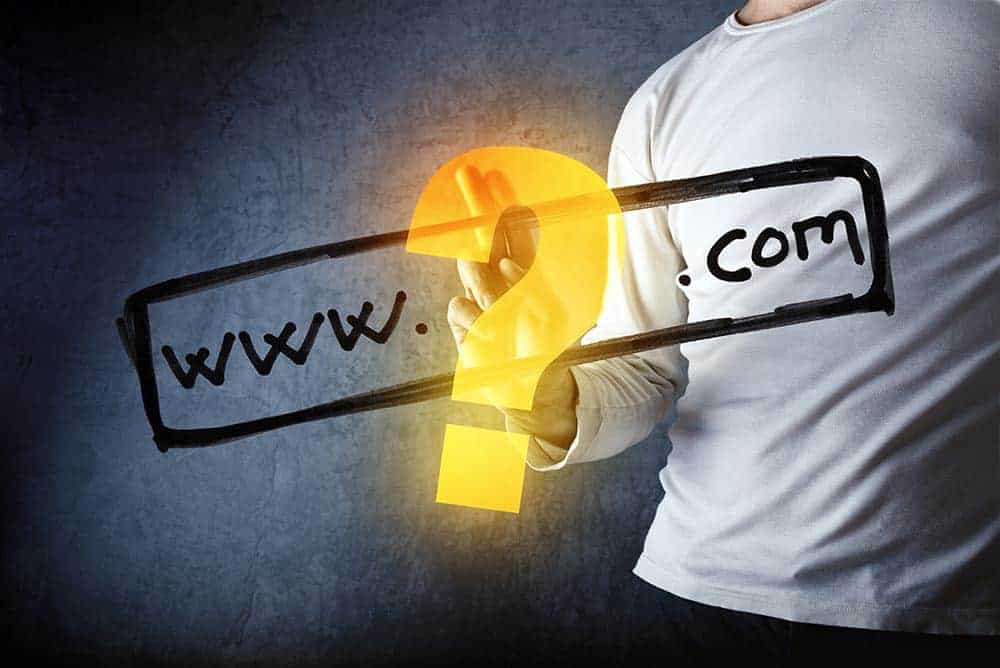One of the hardest aspects of starting a business is coming up with a name for it. Your business name forms part of your brand. It should be easy to remember, relevant to your trade and of course, original. These qualities are important because your business name carries over to your domain name. Now what would you do if you tried to register it and found out the domain name was already taken? You could be a victim of Cybersquatting.
What is Cybersquatting?
Cybersquatting is the act of registering, selling or using a domain name for the purpose of extracting profit from the goodwill of another person’s trademark.
Here is the official definition of cybersquatting from the U.S. Anti-Cybersquatting Consumer Protection Act (ACPA):
“Cybersquatting is the opportunistic practice of registering, trafficking in and using a domain name resembling a trademark belonging to someone else with the aim to profit from it.”
It is difficult to refer to cybersquatters as “enterprising” but they had the foresight of buying domain names of existing businesses that hesitated going online for a long time.
Panasonic, Hertz and Avon are just a few of the large, successful companies that had their domain names held hostage and paid out as much as $15,000 to reclaim them.
The cost of registering a domain name? US$6.00.
Cybersquatting has its roots in the late 1990’s as the Internet moved toward global accessibility. In 1995, the Internet was only accessible to 16 million people or roughly 0.4% of the world’s population.
By the year 2000, 304 million people had Internet connectivity. Today, an estimated 3.88 billion or 52% of the world’s population are on the Internet everyday.
As more businesses migrate their operations online, more opportunities become available for cybersquatters. According to the Arbitration and Mediation Center of the World Intellectual Property Organization (WIPO), it received 2,754 complaints related to cybersquatting in 2015. This was a 5% increase from 2014.
Types of Cybersquatting
The reality is cybersquatters are free to register any domain names that remain available even if these are similar to those that have already been registered.
Domain registration in the United States goes through the Internet Corporation for Assigned Names and Numbers (ICANN). This is a non-profit organization that was formed in November 1998. ICANN was given the responsibility of managing ownership of the Domain System.
A domain name is registered through a master database when you file an application with one of ICANN’s accredited registrars. If the domain name is available and the applicant pays the fee, the applicant automatically becomes the owner of the website name.
Keep this rule in mind when coming up with a business name: Registering domain names is on a first-come, first-serve basis.
ICANN’s registrars are not tasked to check if the applicant of the domain name is related or associated with the business that owns the trademark.
Thus if “mountaintopwebdesign.com” was available, an applicant with no relation to Mountaintop Web Design would be able to acquire the domain name.
Lack of domain name regulation has resulted in cybersquatters coming up with different schemes to profit from holding your trade name hostage:
1. Typosquatting.
This type of cybersquatting goes by other terms such as “URL hijacking”, “a sting site” and “fake URL”. Typosquatters capitalize on mistakes frequently made by Internet users when typing a URL. For example:
- Misspellings – www.mountantopwebdesign.com
- Different Phrasing – www.mountaintopwebdesigns.com
- Use of other domain variations – www.mountaintopwebdesign.net
- Fake website – Looks similar to the authentic website in terms of layout, design and content.
2. Identity Theft.
Cybersquatters use software that allows them to track down domain names which were unintentionally not renewed by the owner. Once the cybersquatter re-registers the domain name, he may link it with a website that duplicates the original. Visitors of the cybersquatter’s website will think they have clicked unto the original website.
3. Name Jacking.
In the United States, your name can avail of trademark protection if it is distinct through advertising, associated as a brand or established as an entity. A good example would be the personal name of a popular celebrity.
But personal names that do not fall under these qualifications cannot avail of trademark protection because people within the same geographic area may have the same name.
Name jacking is the act of registering a domain name associated with an individual. The usual targets are celebrities and other famous people. As an example, pop singer Madonna’s name was used to launch a pornographic site madonna.com.
4. Reverse Cybersquatting.
This is a direct attempt to steal your domain name by taking advantage of existing dispute resolution procedures. The reverse cybersquatter will try to pressure you into transferring its legitimate ownership to another person or organization that has registered a trademark reflected in the domain name.
How Do Cybersquatters Profit?
There are five ways a cybersquatter monetizes these illegal practices:
1. Domain Parking
Redirects a domain name to a website that carries advertisement so it can generate traffic.
2. Domain Name Ransom
Cybersquatter uses domain name to spread ransomware. The malicious program blocks access until the victim pays the amount of the ransom.
3. Affiliate Marketing
Redirects domain name to websites used for selling products and services in exchange for commissions.
4. Hit Stealing
Refers a visitor of the cybersquatted domain name to the website of a competitor.
5. Scamming
This practice covers identity theft and credit card fraud. People who land on a cybersquatted website may be asked to provide confidential information to win prizes in a raffle.
How to Find Out if You Are a Victim of Cybersquatting
So now you have finally decided on a domain name. If you want to know if it is being used by a cybersquatter, simply type the domain name in the address bar , then press “enter” to find out where it will lead you.
Here are a few possible scenarios:
- You land on a website that states “This domain is for sale”, “Under construction” or “Can’t find server”. It becomes increasingly clear that the owner’s purpose is to profit off the sale of the domain name.
- You end up on a fully- functioning website packed with advertisements for products and services similar to those carried under your trademark. The purpose of the cybersquatter is to profit off the goodwill of your trade name.
- You find yourself in a website that has a similar domain name but does not compete with your products or services. This is not a case of cybersquatting but possibly trademark infringement.
It is frustrating to know you cannot use the domain name you worked on and want for your online business. But rather than allow your emotions to take over, breathe, analyze the situation carefully and think of other possibilities.
For example if the web page reads “Under construction”, it is still within the realm of possibility that the owner of the domain name has legitimate plans for the website.
The next step is to find out the identity of the person who owns the domain name. You can do this by going to whois.net and using its “WHOis lookup” feature. Contact the registered owner and see if he or she is willing to sell you the domain name at the right price.
If the price is reasonable then buy the domain name. It will be a cheaper option than going through an arbitration or litigation process.
What to Do if You Are a Victim of Cybersquatting
If it is confirmed that you are a victim of cybersquatting and the domain owner has not shown reasonable interest in negotiating the sale or turnover of the domain name to you, there are two options you can exercise:
- Apply for arbitration procedures under ICANN.
- Sue the domain name owner under the Anticybersquatting Consumer Protection Act or ACPA
How do these two options vary?
Arbitration Through ICANN
ICANN developed and implemented the Uniform Domain Name Dispute Resolution Policy (UDNDRP) in 1999. This policy was designed as a measure for resolving disputes regarding domain names.
The UDNDRP prescribes an arbitration not a litigation process which can be initiated by any person or complainant who argues the following instances to the ICANN:
- That the domain name in question is identical and confusingly similar to a trademark to which the complainant has rights to;
- That the domain name owner has no rights or expressed any legitimate interest in the domain name;
- That the domain name in question which has been registered is being used in bad faith.
If these conditions can be successfully proven, the domain name will be cancelled and rights of use transferred to the complainant. It should be noted that financial remedies are not covered under the UDNDRP.
Litigation Through the ACPA
Under the ACPA, you can sue an alleged cybersquatter in federal court and secure a court order to retrieve the domain name. There have been cases where the cybersquatter will be asked to pay monetary damages.
To win your case versus a cybersquatter, you must be able to prove the following:
- There is bad faith intent to profit from the use of the domain name;
- Your trademark or business name was already distinctive at the time the domain name was registered;
- The domain name is indisputably identical and confusingly similar to your trademark;
- Your trademark qualifies for protection under existing federal trademark laws because it is distinctive and you were the first one to use it for the purpose of commerce.
However if the alleged cybersquatter can prove that he had legitimate reasons to register the domain name without trying to profit by selling it back to the complainant, the federal court may allow him to keep it.
What would be your best option?
Most trademark experts will advise you to go through the arbitration process under ICANN because it is faster and inexpensive as you are not required to have the assistance of an attorney.
Conclusion
With thousands of businesses being registered every day, it can be a challenge finding a trade name that is unique and all your own.
71% of small businesses in the United States have websites. Of the 29% that don’t have websites, 92% say they will put it off until 2018. There is very high possibility that these small business owners will deal with cybersquatters by then.
Don’t be part of the 92%. If you have a business in mind, setting up a mobile responsive website should always be part of your development plan. Once you have a trade name in mind, register it as your domain name right away.
Remember the rule we stated earlier in this article:
Registering domain names is on a first-come, first-serve basis.
At Mountaintop, domain name registration is part of the web design process. We will assist you in securing your domain name before cybersquatters can hold it hostage.
If you want to know more about domain name registration, please feel free to give us a call or drop us an email. We will do our best to keep you from becoming a victim of cybersquatters.







